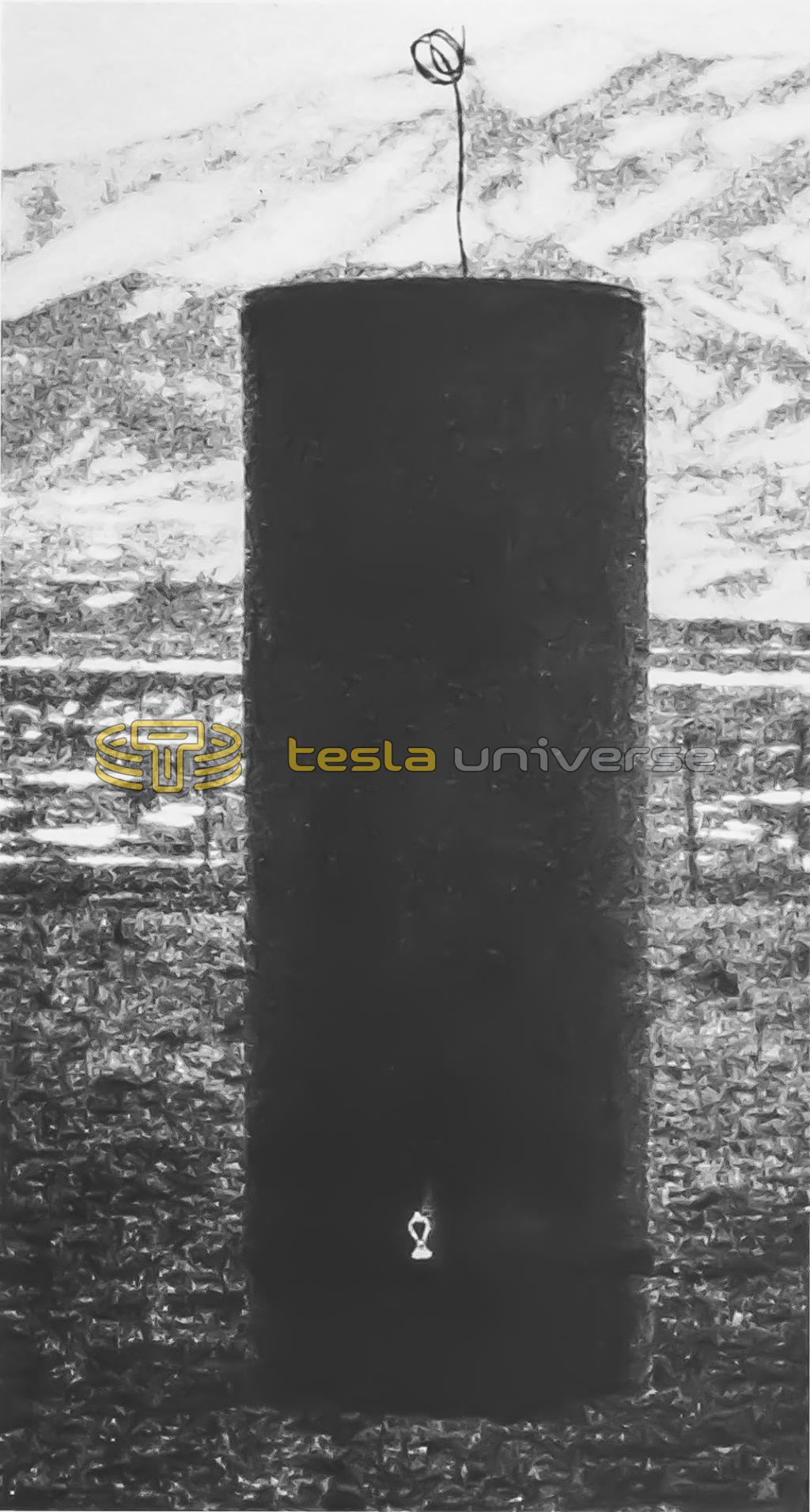
Nikola Tesla Books
Related content from pages
to the primary vibration when the capacity in the primary or exciting circuit was 1 2/3 tanks or 60 bottles on each side, or 30 bottles total, that is, 30 x 0.0009 = 0.027 mfd, total.
The vibrations were impressed on the ground plate by the oscillator with normal connection, that is, two primary cables in multiple or one primary turn, the approximate inductance of which was 56,400 cm or, say, 56,000 cm, which is close enough for the present consideration. This inductance may have been modified by the secondary, but the effect of the latter must have been very slight as, with the capacity used, it was âout of tuneâ and the current through it was necessarily very small. Taking then the inductance of the primary exciting circuit at 56,000 cm, the period of this circuit was
Tp = $! {{2 \pi \over 10^{3}} \sqrt{0.027 \times {56 \over 10^{6}}}} $!.
Now calling Cs the âidealâ capacity of the excited circuit, the period of the same was
Ts = $! {{2 \pi \over 10^{3}} \sqrt{{185 \over 10^{4}} \times C_{s}}} $! and equating we have Cs = $! {{10^{4} \over 185} \times 0.027 \times {56 \over 10^{6}}} $! = $! {{56 \times 0.027} \over {185 \times 10^{2}}} $! mfd,
or Cs = $! {{9 \times 10^{5} \times 56 \times 0.027} \over {185 \times 10^{2}}} $! = $! {{243 \times 56} \over 185} $! = 75.2 cm, approx. From above
Tp = $! {{2 \pi 10^{3}} \sqrt{0.027 \times {56 \over 10^{6}}}} $! = $! {{2 \pi \over 10^{3}} \sqrt{1.512}} $! = $! {{6.28 \over 10^{6}} \times 1.23} $! = $! {7.7244 \over 10^{6}} $!
and n = 129,500 per second nearly.
The theoretical wave length would thus be λ = $! {186,000 \over 130,000} $! = $! {186 \over 130} $! = 1.43 miles approx.
or $! {λ \over 4} $! = $! {1.43 \over 4} $! = 0.3575 miles or 0.3575 x 5280 = 1888 feet = $! {λ \over 4} $!.
The actual length of wire in the experiment was: 274 turns of the coil, each 79.29" = 1810 feet + one piece of wire 304 feet + one piece of wire 84 feet = 1810 + 304 + 84 = 2198 feet or nearly 15% more than the theoretical value. The fact is, the adjustment for resonance was not quite close as the lamp lighted could not withstand the current by closer adjustment. Two of these lamps were broken. The energy transmitted through the ground to the coil was, of course, small in this instance, since only a small part of the available primary capacity was used, that is, $! {1.66 \over 8} $! of the available capacity and the current of the supply transformers was reduced as far as practicable. If a coil especially adapted for the full output of the oscillator would have been used it would have been practicable to transmit many times the amount of energy needed for lighting the lamp. The lamps used in this experiment were special ones each taking, under the conditions of the experiment, perhaps 10 watts or nearly so. Assuming again a circuit under ideal conditions with the capacity of 75.2 cm on the free end of a coil without distributed capacity, and calling the potential to which this capacity would be charged P, the total energy set
in movement in the excited system would be 2 x 129,500 x $! {{P^{2} \times 75.2} \over {2 \times 9 \times 10^{11}}} $! watts.
If we assume that, as before, 1% of the total energy of the system is frittered down in the lamp we would have, in conformity with what was stated before for determining P, the equation
$! {2 \times 129,500 \times {{P^{2} \times 75.2} \over {2 \times 9 \times 10^{11}}}} $! = 1000 or P2 = $! {{18 \times 10^{11}} \over 259} $!
or
P = $! {10^{5} \sqrt{180 \over 259}} $! = $! {10^{5} \sqrt{0.695}} $! = $! {10^{5} \times 0.834} $!
or 83,400 V nearly, which is a small e.m.f. The length of wire in excited circuit was as before stated 2198 feet; the wire being No. 10, with a resistance of 1 ohm per one thousand feet, the resistance of the circuit was about 2.2 ohm. From above p = 2Ïn was = 6.28 x 129,500 = 813,260 or, say, 813,000 = p. The inductance being, as shown, $! {185 \over 10^{4}} $! henry, the magnifying factor in the coil was $! {{{185 \over 10^{4}} \times 813 \times 10^{3}} \over 2.2} $! = 6840 nearly. The lamp was one with a very short filament and its resistance may have been possibly 6 ohms. Thus with the lamp comprised the magnifying factor was still very considerable, that is, $! {{185 \times 813} \over 82} $! = 1830 or nearly so. Taking it at 1800 we see that it was necessary, under the conditions assumed, to impress upon the ground plate, or near portions of the ground an electromotive force of only $! {83,400 \over 1800} $! = $! {834 \over 18} $! = 52 volts or nearly so! This seems very little indeed, it can be scarcely believed, but the figures seem to be not far from truth. These remarks refer particularly to the experiment illustrated on the plate marked XXIV. in which the connections were the same as in the diagram shown when discussing Plate XXII., the lamp or lamps being in series with the excited coil or system.
Related content from annotations
Hertz, H.R. UNTERSUCHUNGEN UBER DIE AUSBREITUNG DER ELEKTRISCHEN KRAFT, dritte auflage, Leipzig, 1914, Johann Ambrosius Barth.
Tesla: âThe problem of increasing human energyâ, The Cent. Illustr. Mon. Magazine, June 1900, A-109.

